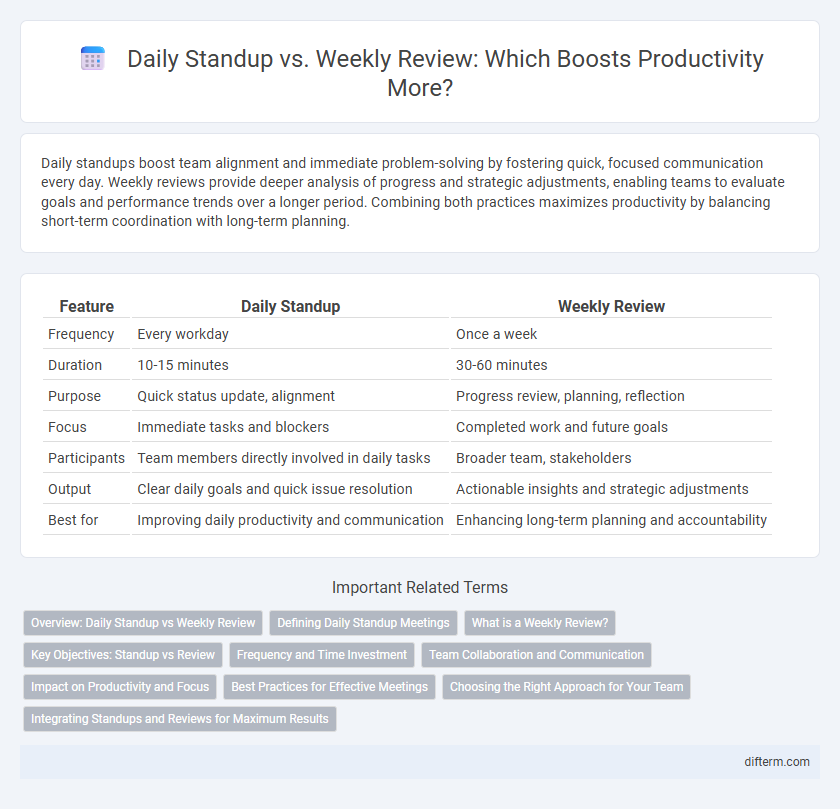Daily standups boost team alignment and immediate problem-solving by fostering quick, focused communication every day. Weekly reviews provide deeper analysis of progress and strategic adjustments, enabling teams to evaluate goals and performance trends over a longer period. Combining both practices maximizes productivity by balancing short-term coordination with long-term planning.
Table of Comparison
| Feature | Daily Standup | Weekly Review |
|---|---|---|
| Frequency | Every workday | Once a week |
| Duration | 10-15 minutes | 30-60 minutes |
| Purpose | Quick status update, alignment | Progress review, planning, reflection |
| Focus | Immediate tasks and blockers | Completed work and future goals |
| Participants | Team members directly involved in daily tasks | Broader team, stakeholders |
| Output | Clear daily goals and quick issue resolution | Actionable insights and strategic adjustments |
| Best for | Improving daily productivity and communication | Enhancing long-term planning and accountability |
Overview: Daily Standup vs Weekly Review
Daily standups offer brief, focused updates that keep teams aligned on immediate tasks and obstacles, enhancing real-time collaboration. Weekly reviews provide a comprehensive reflection on progress, challenges, and strategic adjustments, facilitating in-depth analysis and long-term planning. Balancing the immediate task tracking of daily standups with the holistic evaluation of weekly reviews optimizes productivity and team performance.
Defining Daily Standup Meetings
Daily standup meetings are short, focused gatherings designed to align team members on immediate tasks and obstacles, promoting real-time communication and swift issue resolution. These meetings typically last 10-15 minutes and occur every morning to ensure progress transparency and agile collaboration. Unlike weekly reviews that assess broader project milestones and strategic goals, daily standups emphasize immediate priorities and daily accountability.
What is a Weekly Review?
A Weekly Review is a dedicated meeting or session where teams assess progress, identify obstacles, and plan priorities for the upcoming week, enhancing long-term project alignment and productivity. Unlike the Daily Standup, which addresses immediate daily tasks and quick updates, the Weekly Review provides deeper insights into overall goals, milestones, and resource allocation. This reflection and strategic planning session helps teams stay on track and adapt workflows effectively.
Key Objectives: Standup vs Review
Daily standups emphasize immediate alignment on key objectives by facilitating quick updates, identifying roadblocks, and synchronizing team efforts to maintain momentum. Weekly reviews provide a broader evaluation of progress against strategic goals, allowing teams to analyze achievements, adjust priorities, and plan upcoming tasks with a focus on long-term outcomes. Both practices optimize productivity by ensuring continuous focus on critical objectives through different timeframes and levels of detail.
Frequency and Time Investment
Daily standups require a short time investment of 10-15 minutes each day, promoting continuous team alignment and quick issue resolution. Weekly reviews, typically lasting 30-60 minutes, offer a deeper reflection on progress and strategic adjustments but demand a larger single time commitment. Choosing between daily standups and weekly reviews depends on the need for frequent updates versus periodic in-depth analysis to maximize productivity.
Team Collaboration and Communication
Daily standups enhance team collaboration by promoting real-time communication, quick issue resolution, and daily alignment of goals, which keeps projects on track. Weekly reviews offer a broader perspective, allowing teams to assess progress, identify patterns, and plan strategically for upcoming tasks. The combination of both practices optimizes communication flow and strengthens overall team productivity.
Impact on Productivity and Focus
Daily standups boost productivity by promoting immediate issue resolution and maintaining team alignment, leading to enhanced focus on short-term goals. Weekly reviews facilitate deeper reflection and strategic adjustments, improving long-term planning and overall project direction. Balancing both rituals optimizes workflow efficiency and sustained team focus across different time horizons.
Best Practices for Effective Meetings
Daily standups boost team alignment by fostering quick, focused updates on progress and impediments, enhancing transparency and immediate problem-solving. Weekly reviews provide a comprehensive overview of accomplishments, challenges, and strategic planning, enabling deeper reflection and adjustment of goals. Combining both formats ensures continuous communication flow while supporting long-term project tracking and team accountability.
Choosing the Right Approach for Your Team
Daily standups foster real-time communication and quick issue resolution, enhancing team alignment and responsiveness. Weekly reviews offer comprehensive progress tracking and strategic reflection, ideal for projects requiring in-depth analysis and planning. Selecting the right approach depends on your team's workflow, project complexity, and the need for frequent updates versus detailed evaluations.
Integrating Standups and Reviews for Maximum Results
Daily standups sharpen team alignment by addressing immediate tasks and obstacles, fostering quick decision-making and continuous progress. Weekly reviews provide a broader perspective, evaluating overall project milestones, performance metrics, and strategic adjustments needed for long-term success. Integrating standups with weekly reviews creates a feedback loop that balances real-time problem-solving with reflective planning, maximizing productivity and maintaining project momentum.
Daily standup vs Weekly review Infographic

 difterm.com
difterm.com